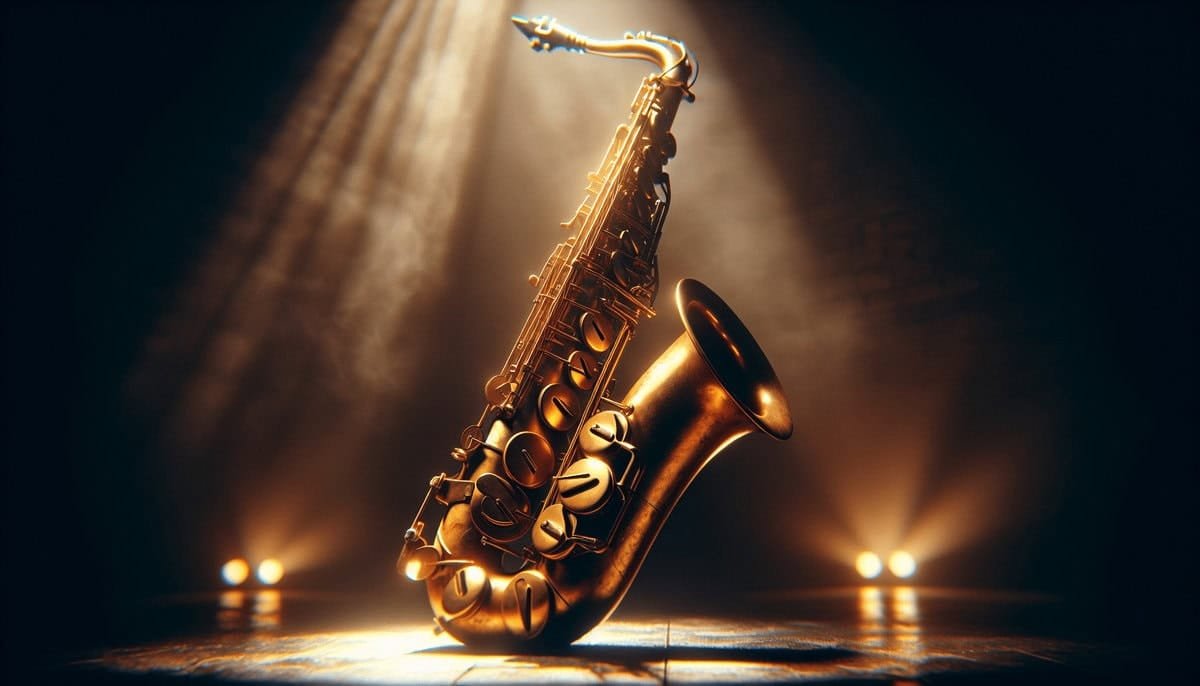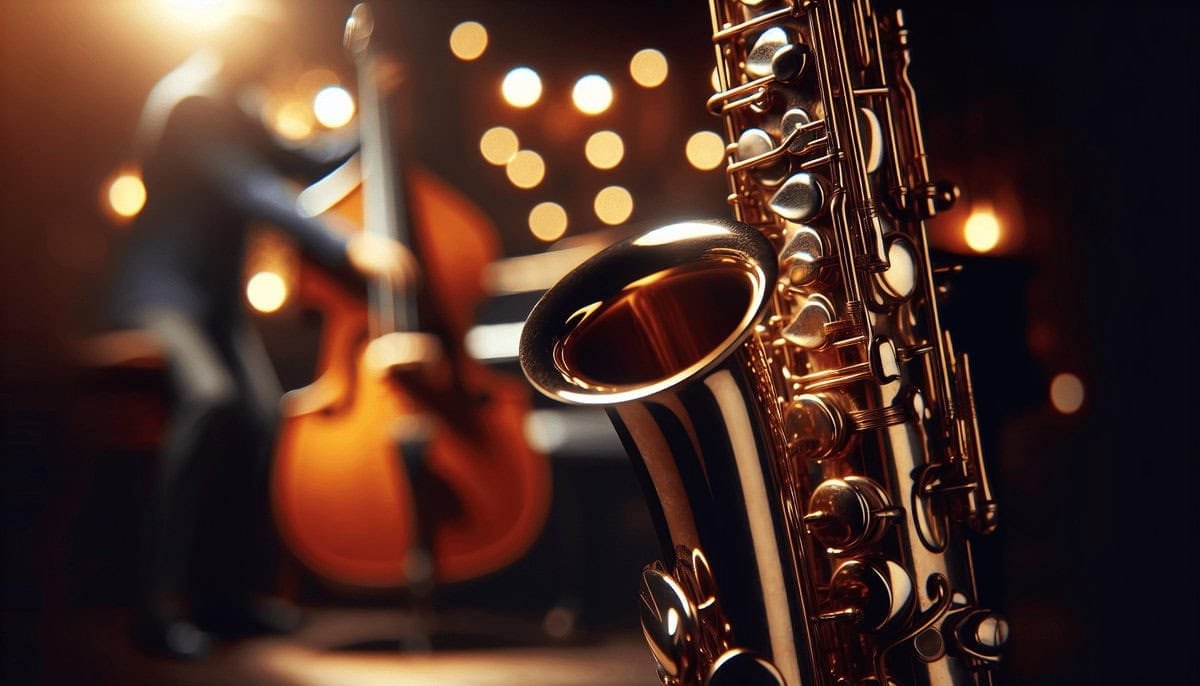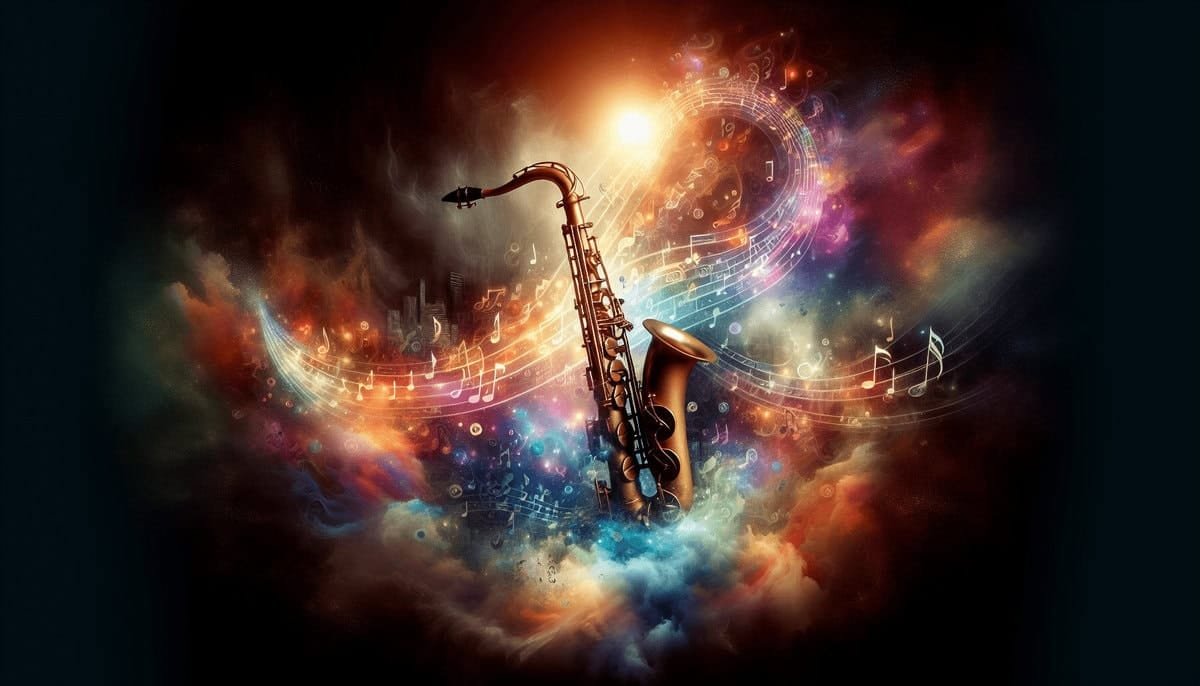So, you're curious about hard bop from 1955 to 1965, huh? Imagine jazz tossing off its cool shades and diving headfirst into a vibrant pool of emotion! This genre blended gospel and rhythm and blues, bringing a bluesy essence that felt like a warm hug. You'd meet icons like Horace Silver and Cannonball Adderley, whose soulful sounds reel you in. Albums like Miles Davis's "Kind of Blue" became instant classics, tackling social issues and cultural pride. It's like jazz decided it wanted to tell stories. Stick around, and you might just find your own rhythm in this musical whirlwind!
Key Takeaways
- Hard bop emerged in the mid-1950s as a response to cool jazz, emphasizing emotional expression and cultural roots in gospel and blues.
- Influential musicians like Horace Silver, Cannonball Adderley, and Art Blakey shaped hard bop's sound through innovative compositions and bold improvisation.
- Collaborations among artists, such as John Coltrane and Miles Davis, bridged hard bop with other jazz styles, expanding its musical boundaries.
- Hard bop addressed themes of Black identity and social issues, creating a powerful emotional connection with audiences through personal storytelling.
- The genre's legacy continues to influence contemporary jazz and various music styles, with modern artists reviving its vibrant essence and narrative power.
Origins of Hard Bop
The emergence of hard bop in the mid-1950s marked a significant shift in jazz, as musicians sought a more emotional and expressive sound. You see, after the cool jazz craze, some artists felt like they were stuck in a musical icebox—everything was so chill, it was practically frozen! They craved something with a little more heart, a little more heat. So, they dug deep into their cultural roots, pulling inspiration from gospel and blues, and bam! Hard bop was born.
This genre blended bebop's complex improvisation with the infectious rhythms of rhythm and blues, creating a sound that was heavy and vibrant. Imagine a jam session at Minton's Playhouse in New York City, where musicians gathered after hours, sharing ideas like they were passing around snacks at a sleepover—candy for the ears!
These late-night sessions sparked creativity and collaboration, leading to a jazz evolution that resonated with the social changes of the time, like the Civil Rights Movement.
In this vibrant atmosphere, hard bop became a voice for a generation, echoing the struggles and triumphs of African Americans. Talk about a jazzy revolution!
Key Influential Musicians
Alright, let's talk about the musicians who really made hard bop what it is—because, let's be honest, without them, we'd just be left with a lot of silence and awkward shuffling of feet.
You've got Horace Silver, with his gospel-inspired tunes that make you want to dance, and Cannonball Adderley, who could make a saxophone sing like it's auditioning for a Broadway show.
Each of these artists brought something unique to the table, creating a sound that's as vibrant and exciting as your favorite playlist—if only my playlists had that kind of flair!
Pioneering Hard Bop Artists
Frequently celebrated as pioneers of hard bop, several key musicians shaped the genre's sound and direction in the 1950s.
You might've heard of Horace Silver, whose innovative compositions mixed jazz with elements of gospel and blues—just listen to "Song for My Father" and try not to tap your foot. Good luck with that!
Then there's Cannonball Adderley, an alto saxophonist whose soulful playing can make even the grumpiest cat feel something—check out "Mercy, Mercy, Mercy" and see if you don't smile!
Art Blakey, the legendary drummer, led the Jazz Messengers, a band that was like a jazz boot camp for young talent. He really knew how to keep the rhythm alive!
Jackie McLean, with his distinct tone and expressive improvisation, added depth to hard bop, especially in albums like "One Step Beyond."
And let's not forget Thelonious Monk, who, while he'd his bebop roots, sprinkled his unique harmonic magic on hard bop, influencing countless artists.
Innovative Composers and Arrangers
During the vibrant era of hard bop, innovative composers and arrangers emerged, pushing the genre's boundaries and solidifying its identity. You might be surprised to learn how influential these musicians were, so here are a few highlights:
- Horace Silver, with his catchy tunes, blended jazz, gospel, and blues like a chef on a cooking show.
- Cannonball Adderley brought emotional depth to the genre, especially with "Mercy, Mercy, Mercy," which could make even a stone statue tap its foot.
- Thelonious Monk, known for his bebop roots, tweaked hard bop's harmonic language like a mad scientist, inspiring many young musicians to embrace their quirks.
- Art Blakey led the Jazz Messengers, creating a musical playground that encouraged bold improvisation and fresh ideas, kind of like a jazz summer camp.
These composers and arrangers used unique compositional techniques and arranging styles that defined hard bop. Jackie McLean, for instance, pushed boundaries with "A Fickle Sonance," showcasing emotional complexity.
Impactful Collaborations and Groups
Collaboration has always been at the heart of hard bop, fueling its evolution and enriching its sound. You know, it's like a potluck dinner where everyone brings their best dish. Art Blakey and the Jazz Messengers were essential in this, creating a space for young musicians to shine. Their collaborative dynamics produced some unforgettable music. Just imagine the jam sessions—no one knew who'd bring the best solo, but they all brought something special.
Check out the table below for a taste of key collaborations:
| Artist/Group | Notable Collaborations | Impact on Hard Bop |
|---|---|---|
| Art Blakey | Jazz Messengers | Platform for young talent |
| Horace Silver | Blakey's group | "The Preacher," gospel influences |
| Cannonball Adderley | Miles Davis, Nat Adderley | Emotional expressiveness |
| John Coltrane | Miles Davis ("Kind of Blue") | Bridged hard bop and modal jazz |
| Jackie McLean | Charles Mingus, own groups | Innovative improvisation |
These musicians didn't just play together; they fused genres, creating a beautiful mess of sounds that still resonates today. It's like a musical family reunion, minus the awkward small talk!
Musical Characteristics Explained
So, let's talk about the heart and soul of hard bop—its bluesy and gospel roots, which honestly make me feel like I should be tapping my feet while sipping a cold drink on a summer day.
You'll notice that the melodies are often simpler, but trust me, they pack a punch, kinda like that time I tried to impress my friends with my cooking skills—simple ingredients, but oh boy, the flavor!
As we explore these musical characteristics, you'll see how they blend together to create something truly special, just like that legendary recipe that everyone tries but never quite gets right.
Blues and Gospel Influences
Drawing from the rich traditions of blues and gospel, hard bop musicians crafted a sound that deeply resonated with the African American experience. You can almost feel the intensity in every note, like when you accidentally step on a Lego—it's raw and real!
Here's how they did it:
- Gospel Harmonies: Musicians simplified piano chords to evoke that church-like vibe. It's like a musical sermon, preaching to your soul.
- Blues Improvisation: The saxophonists released wider, harsher tones, adding grit and emotion that made you want to sway like you're at a family reunion.
- Repetitive Bass Lines: Tracks like Cannonball Adderley's "This Here" featured catchy riffs that stick in your head—kind of like that jingle you can't shake.
- Rhythmic Foundation: Afro-Latin rhythms danced alongside the strong beats, giving you a foot-tapping experience that even your grandma would appreciate.
In this way, hard bop became a musical platform for emotional and cultural expression, addressing social issues through its lyrical content.
Simplified Melodic Structures
Emphasizing simplicity, hard bop musicians crafted melodic structures that resonate deeply with listeners. You know, it's like when you hear a catchy tune and suddenly can't get it out of your head—this is the essence of melodic accessibility in hard bop. Unlike the intricate lines of bebop that often leave you scratching your head, hard bop draws heavily from blues and gospel traditions, making it feel more relatable.
Take those repetitive bass line riffs, for example. They provide a solid foundation, almost like a reliable friend who's always got your back during a karaoke night. Plus, the incorporation of Afro-Latin rhythms adds a lively bounce, making you want to tap your feet and sway along—yes, even if you have two left feet like me!
The piano parts often feature simplified chords that echo gospel vibes, emphasizing the melodic and improvisational aspects. Just listen to Cannonball Adderley Quintet's "This Here," and you'll find straightforward yet powerful melodies that tug at your heartstrings.
It's all about emotional resonance, inviting you to connect with the music, even if you can't quite name that chord!
Notable Recordings and Albums
During the transformative years of hard bop, from 1955 to 1965, several notable recordings emerged that not only defined the genre but also showcased the creativity of its key artists.
If you think jazz is just a bunch of notes thrown together, let me introduce you to some album highlights that might change your mind!
- Miles Davis – "Kind of Blue": This album is so iconic it's practically a household name.
- Charles Mingus – "Mingus Ah Um": It's a wild ride of innovative compositions, reflecting deep social issues and jazz traditions—seriously, Mingus was ahead of his time!
- Thelonious Monk – "Brilliant Corners": If you ever wanted to be confused by complex structures, this one's for you. But trust me, it's genius.
- Horace Silver – "Further Explorations": This album blends blues and gospel like peanut butter and jelly—comfort food for the ears!
These defining tracks not only shaped hard bop but also invite you to reflect on the depths of jazz.
You may find yourself humming along, trying to sound sophisticated, while secretly wondering if you can dance to it!
Cultural Impact and Significance
Hard bop didn't just change the sound of jazz; it also made a powerful statement about the cultural and social landscape of its time. Imagine yourself in the 1950s, feeling the reverberations of a genre that spoke directly to the struggles and triumphs of Black communities. Hard bop emerged as a vibrant cultural expression, mixing elements of gospel, blues, and rhythm and blues—it was like a musical hug for those seeking authenticity in a world that often felt cold.
Here's a little table that sums it up:
| Aspect | Impact |
|---|---|
| Cultural Identity | Emphasized Black cultural roots and pride |
| Social Commentary | Addressed racism and inequality |
| Emotional Connection | Focused on personal storytelling |
| Influential Albums | Miles Davis's "Kind of Blue" |
| Innovative Venues | Fostered creativity and new artists |
Reception and Critical Perspectives
As the vibrant sounds of hard bop began to resonate in the jazz scene, critics and scholars quickly took notice, recognizing its profound impact on both music and culture.
You might find it interesting that:
- David H. Rosenthal's book, "Hard Bop: Jazz and Black Music 1955-1965," is praised for its lively exploration of the genre's roots.
- Library Journal lauds Rosenthal's open-minded approach, highlighting hard bop's creative significance during its peak.
- Some critics, however, point out the book's limitations, especially regarding the perceived decline of hard bop post-1960s.
- Customer reviews rave about the engaging prose, making it accessible for both jazz newbies and seasoned pros.
In scholarly discourse, Rosenthal's work is a staple, but it's not without its quirks.
For instance, you might wonder why Max Roach, a drumming genius, doesn't get enough love here.
Still, that discography? Gold! It's like a treasure map for those enthusiastic to dive deeper into the recordings that made hard bop a thing.
Legacy and Modern Influence
The legacy of hard bop resonates deeply in the fabric of modern jazz, influencing a myriad of genres and artists. You might not realize it, but when you groove to contemporary jazz, you're often tapping your feet to hard bop's rhythm. It's like finding out that your favorite pizza place has a secret family recipe; it just makes sense!
Here's a quick look at how hard bop influenced various artists and genres:
| Genre/Artist | Influence | Examples |
|---|---|---|
| Soul Jazz | Blues and gospel elements | Horace Silver, Cannonball Adderley |
| Modal Jazz | Emotional expressiveness | Miles Davis, John Coltrane |
| Contemporary Jazz | Rhythmic complexity | Christian Scott, Ambrose Akinmusire |
| Social Commentary | Addressing identity issues | Modern artists using hard bop's narrative power |
| Revival | Blending traditional styles | Incorporating cultural themes |
You see, hard bop's revival isn't just a retro trend; it's a vibrant part of today's music scene. So, next time you catch a jazz show or spin a record, remember that those soulful notes are carrying on a tradition, one that's as rich and complex as your grandma's secret sauce—only with more trumpets!
Future of Hard Bop
While hard bop has left an indelible mark on modern jazz, its journey isn't over. You might be wondering, "What's next for this genre?"
Well, here are a few future directions you can keep an ear out for:
- Innovative Compositions: Artists like Christian Scott and Ambrose Akinmusire are blending hard bop with new sounds, making it fresh and exciting.
- Cultural Roots: The emotional expression that hard bop emphasizes continues to inspire musicians to dig deep into their backgrounds and share those stories.
- Jazz Festivals & Education: These celebrations keep hard bop alive, teaching new generations about its significance and stylistic evolution.
- New Collaborations: Emerging artists often reference hard bop's rhythmic and harmonic structures, ensuring its relevance in today's jazz scene.
Conclusion
So, as we wrap up this jazzy journey through hard bop, picture yourself in a smoky club, toes tapping to those swinging beats. It's like being wrapped in a warm blanket of sound, right? Hard bop didn't just shake up jazz; it stirred the pot of culture, too. Sure, I might trip over my own feet trying to dance to it, but that's part of the fun! Here's to the rhythms that still inspire us to groove, laugh, and maybe even trip a little.



